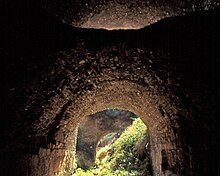Nysa Bridge
Nysa Bridge | |
|---|---|
 | |
| Coordinates | 37°54′12″N 28°08′44″E / 37.903405°N 28.145514°E |
| Carries | Substructure for theatre square |
| Crosses | Cakircak |
| Locale | Nysa (Sultanhisar), Caria, Turkey |
| Characteristics | |
| Design | Arch bridge |
| Material | Stone |
| Width | c. 100 m |
| Longest span | 5.7–7 m |
| No. of spans | 1 (bottom vault) |
| Clearance below | 5.9 m |
| Location | |
 | |
The Nysa Bridge is a late imperial Roman bridge over the Cakircak stream in Nysa (modern Sultanhisar) in the ancient region of Caria, modern-day Turkey. The 100 m (328 ft) long substructure was the second largest of its kind in antiquity, after the Pergamon Bridge.[1]
Dating[edit]
The Greek geographer Strabo (63 BC–AD 21), who lived in Nysa, mentioned a secret water conduit in the town, but it remains unclear whether he meant the existing tunnel-like bridge.[2] An inscription at the northern wall of the tube, close to a bend after 25 m (82 ft), indicates a construction date in late imperial times.[3] It reads "Work of Praülos until this point".[4]
Construction[edit]

The Nysa Bridge served as a substructure for the area in front of the city theatre, which lay close to the Cakircak stream.[5] It was built as a two-level structure: the bottom vault spanned the brook. On top of it a row of arches connected the two hills that formed the urban area. The ground arch spanned the stream on a length of some 100 m (328 ft), giving the bridge the appearance of a tube or a tunnel, although it was constructed entirely above ground. It consists of a single, 5.7 m (19 ft) wide vault whose uphill mouth widens to 7 m (23 ft). The overall height of its semi-circular arch is 5.9 m (19 ft), featuring a rise of 2.95 m (9 ft 8 in). The vault is made of rubble stone laid in mortar, resting on a substructure of ashlar stone blocks of varying size (0.3–0.9 x 1.0–1.4 m). Originally featuring a continuous vaulting, it is collapsed today between m 75 and 85, and again at the downhill exit. The remaining, isolated structure at the downstream side has often been incorrectly referred to as a bridge of its own.[6] The Nysa Bridge was the second largest bridge substruction of its kind in antiquity, only surpassed by the nearby Pergamon Bridge.[1] By comparison, the width of a normal, free standing Roman bridge did not exceed 10 m (33 ft).[7]
In its further course, the Cakircak also ran through the city stadion, so that naumachia could be given. There are remains of two other ancient bridges both up- and downstream.[2]
Discharge capacity[edit]
The capacity limit of the Nysa Bridge in case of floods has been the subject of hydraulic and hydrological research. The gradient of the tunnel was calculated as 3.3% with a maximum discharge capacity of 290 m³/s. Exceeding this limit puts the bridge under internal pressure and damages the structure in the process. Considering that the Cakircak is 6 km (3.7 mi) long, with a median gradient of 19% and a drainage basin of 4 km2 (1.5 sq mi), the following median intervals were calculated, depending on the method employed:
- 7,500 years (Günerman method)
- 10,500 years (D.S.I. method)
- 13,000 years (Mockus method)
- 68,000 years (Snyder method)
The study came to the conclusion that statistically every 13,500 years, a value which has been referred to as the "arithmetic mean", floods are to be expected which would exceed the capacity of the bridge.[8]
See also[edit]
References[edit]
- ^ a b Grewe & Özis 1994, p. 352
- ^ a b Grewe & Özis 1994, p. 350
- ^ Grewe & Özis 1994, p. 351
- ^ Archaiologikon Deltion 1921–22, 84: Π̣ραΰ̣λου ἔργον | ἕως ὧδε
- ^ Grewe & Özis 1994, p. 348f.
- ^ All data: Grewe & Özis 1994, p. 351
- ^ O’Connor 1993
- ^ Grewe & Özis 1994, p. 351f.
Sources[edit]
- Grewe, Klaus; Özis, Ünal (1994), "Die antiken Flußüberbauungen von Pergamon und Nysa (Türkei)", Antike Welt, 25 (4): 348–352
- O’Connor, Colin (1993), Roman Bridges, Cambridge University Press, ISBN 0-521-39326-4
Further reading[edit]
- Öziş, Ünal; Harmancioğlu, N. (1979), "Flood Flows and Capacities of the Historical Pergamon and Nysa Tunnels in Anatolia", International Association for Hydraulic Research, 18. Congress Proceedings, 6, Cagliari: 696–698
- Öziş, Ünal (1987), "Ancient Water Works in Anatolia", Water Resources Development, 3/1: 55–62
External links[edit]
![]() Media related to Nysa Bridge at Wikimedia Commons
Media related to Nysa Bridge at Wikimedia Commons

